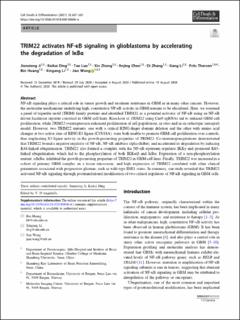| dc.description.abstract | NF-κB signaling plays a critical role in tumor growth and treatment resistance in GBM as in many other cancers. However, the molecular mechanisms underlying high, constitutive NF-κB activity in GBM remains to be elucidated. Here, we screened a panel of tripartite motif (TRIM) family proteins and identified TRIM22 as a potential activator of NF-κB using an NF-κB driven luciferase reporter construct in GBM cell lines. Knockout of TRIM22 using Cas9-sgRNAs led to reduced GBM cell proliferation, while TRIM22 overexpression enhanced proliferation of cell populations, in vitro and in an orthotopic xenograft model. However, two TRIM22 mutants, one with a critical RING-finger domain deletion and the other with amino acid changes at two active sites of RING E3 ligase (C15/18A), were both unable to promote GBM cell proliferation over controls, thus implicating E3 ligase activity in the growth-promoting properties of TRIM22. Co-immunoprecipitations demonstrated that TRIM22 bound a negative regulator of NF-κB, NF-κB inhibitor alpha (IκBα), and accelerated its degradation by inducing K48-linked ubiquitination. TRIM22 also formed a complex with the NF-κB upstream regulator IKKγ and promoted K63-linked ubiquitination, which led to the phosphorylation of both IKKα/β and IκBα. Expression of a non-phosphorylation mutant, srIκBα, inhibited the growth-promoting properties of TRIM22 in GBM cell lines. Finally, TRIM22 was increased in a cohort of primary GBM samples on a tissue microarray, and high expression of TRIM22 correlated with other clinical parameters associated with progressive gliomas, such as wild-type IDH1 status. In summary, our study revealed that TRIM22 activated NF-κB signaling through posttranslational modification of two critical regulators of NF-κB signaling in GBM cells. | en_US |

